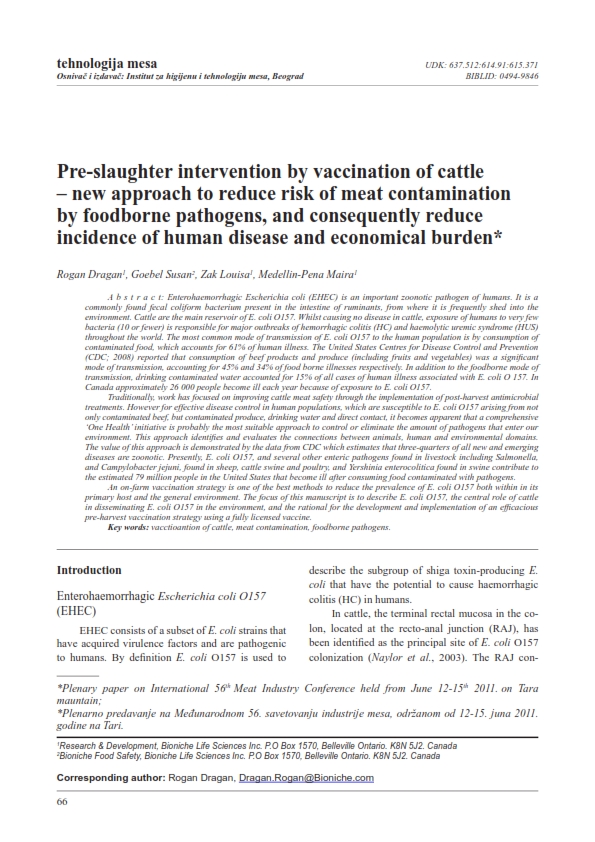Pre-slaughter intervention by vaccination of cattle – new approach to reduce risk of meat contamination by foodborne pathogens, and consequently reduce incidence of human disease and economical burden
Abstract
Enterohaemorrhagic Escherichia coli (EHEC) is an important zoonotic pathogen of humans. It is a commonly found fecal coliform bacterium present in the intestine of ruminants, from where it is frequently shed into the environment. Cattle are the main reservoir of E. coli O157. Whilst causing no disease in cattle, exposure of humans to very few bacteria (10 or fewer) is responsible for major outbreaks of hemorrhagic colitis (HC) and haemolytic uremic syndrome (HUS) throughout the world. The most common mode of transmission of E. coli O157 to the human population is by consumption of contaminated food, which accounts for 61% of human illness. The United States Centres for Disease Control and Prevention (CDC; 2008) reported that consumption of beef products and produce (including fruits and vegetables) was a significant mode of transmission, accounting for 45% and 34% of food borne illnesses respectively. In addition to the foodborne mode of transmission, drinking contaminated water accounted for 15% of all cases of human illness associated with E. coli O 157. In Canada approximately 26 000 people become ill each year because of exposure to E. coli O157. Traditionally, work has focused on improving cattle meat safety through the implementation of post-harvest antimicrobial treatments. However for effective disease control in human populations, which are susceptible to E. coli O157 arising from not only contaminated beef, but contaminated produce, drinking water and direct contact, it becomes apparent that a comprehensive ‘One Health’ initiative is probably the most suitable approach to control or eliminate the amount of pathogens that enter our environment. This approach identifies and evaluates the connections between animals, human and environmental domains. The value of this approach is demonstrated by the data from CDC which estimates that three-quarters of all new and emerging diseases are zoonotic. Presently, E. coli O157, and several other enteric pathogens found in livestock including Salmonella, and Campylobacter jejuni, found in sheep, cattle swine and poultry, and Yershinia enterocolitica found in swine contribute to the estimated 79 million people in the United States that become ill after consuming food contaminated with pathogens. An on-farm vaccination strategy is one of the best methods to reduce the prevalence of E. coli O157 both within in its primary host and the general environment. The focus of this manuscript is to describe E. coli O157, the central role of cattle in disseminating E. coli O157 in the environment, and the rational for the development and implementation of an efficacious pre-harvest vaccination strategy using a fully licensed vaccine.





